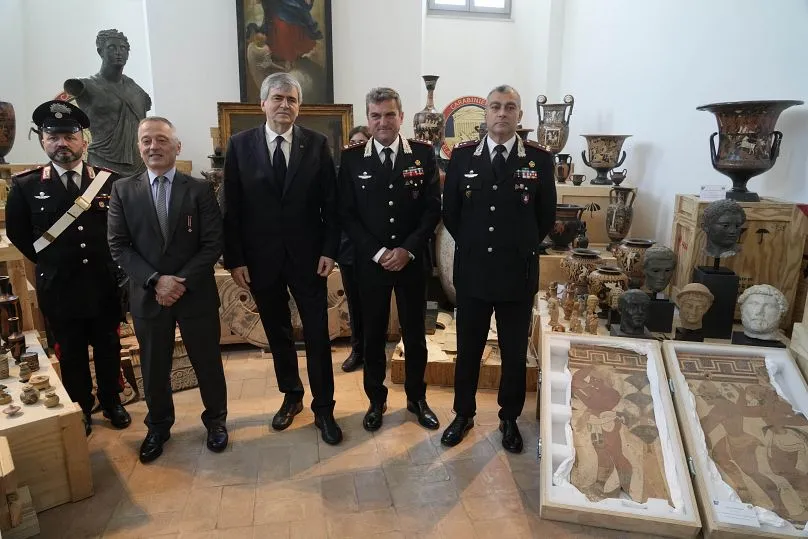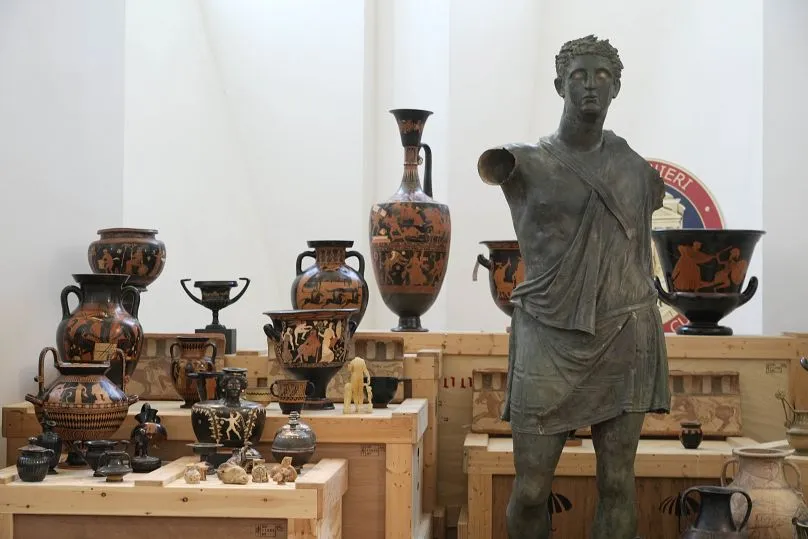Italy is celebrating the return of 266 antiquities, including Etruscan vases and ancient Roman coins and mosaics worth tens of millions of euros, that were looted and sold to American museums and private collectors. The artifacts, which were displayed during a handing-over ceremony at the offices of the Manhattan district attorney, were recovered from a storage unit belonging to British antiquities dealer Robin Symes and had been offered to Houston’s Menil Collection but were declined. The Menil Collection denied ever owning the artifacts, stating that they were approached by a collector about making a gift of the items in 2022, but the museum’s curator directed the collector to the Italian culture minister, who informed the museum that Italy was claiming the objects.
The Italian Carabinieri, the country’s paramilitary police force, launched an investigation into the artifacts and determined that they had come from clandestine excavations of archaeological sites. The owner of the collection then “spontaneously” returned the items to Italian authorities. The Carabinieri stated that the works had been part of the Menil Collection, but the museum denied this, saying they never owned the artifacts.
The artifacts include an Apulian krater, or vase, dating from 335 BC, which had been seized in July from a private collection in New York. The vase had been photographed and included in the famous Polaroid “archive” of dealer Giacomo Medici, who passed it onto Symes, who then “laundered the piece through Sotheby’s London”.
The haul also includes two Etruscan tile paintings from Cerveteri, a frequently-looted necropolis site north-west of Rome, which date back to 440 BC. The tiles were looted in the 1980s and ended up with Symes, who sold them to noted New York collectors Shelby White and Leon Levy in 1992 for 1.6 million dollars.

Italy Recovers Hundreds of Stolen Antiquities
The Italian culture ministry has been campaigning for decades to recover looted antiquities, including those sold to American museums and private collectors. The recovery of the artifacts is a major victory for the country, as it helps to preserve Italy’s cultural heritage and recover stolen cultural property.
The value of the recovered artifacts, if sold on the open market, would total tens of millions of euros. The Italian police art squad stated that the return of the artifacts was a significant achievement, as it brings an end to the illegal trafficking of cultural property.
The recovery of the artifacts is also a significant blow to the illegal art trade, which has been plagued by the looting of archaeological sites and the sale of stolen cultural property to unsuspecting collectors and museums. The case serves as a reminder of the importance of provenance and due diligence in the art market, and highlights the need for greater cooperation between law enforcement agencies and cultural institutions to recover stolen cultural property.
The return of the artifacts also marks a major milestone in the long-standing campaign by Italy to recover its stolen cultural heritage. The country has been fighting to recover its cultural property for decades, and the recovery of the artifacts is a significant step forward in this effort.











































